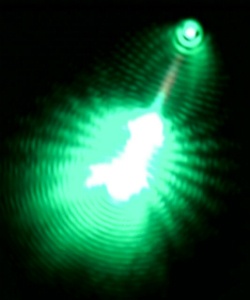
When you think about microprocessors and chipsets and circuit boards, if you’re like me, you think in metaphors: tiny green-and-silver cities comprising dozens of chips — some with billions of transistors — on copper trace-linked highways, channeling information as digital 1’s and o’s through electrical signals on a microscopic scale. For this, I blame Tron.
Now — keeping with the yes-I’m-an-’80s-child Tron metaphor — imagine that “city” instead channeling light.
(MORE: Netatmo Home Weather Station Kit Brings Out Your Inner Meteorologist)
It’s a research dream, to use bursts of light instead of electricity to move computer information around at unheard of speeds. Instead of electronics, think photonics, a science devoted to studying and applying photons — the basic unit or “quantum” of light — to industrial fields that range from lasers and light detection to robotics, holography and quantum computing.
And we’re now a step closer to that dream, thanks to researchers at the University of Pennsylvania, who’ve managed to create the world’s first “all-optical photonic switch” — a switch that’s essentially run on light. Why try to wrangle light into something like a switch? To stay one step ahead of what the Penn researchers describe as “the imminent limitations of electronic integrated circuits.”
You’ve probably heard something about that before, the demise of Gordon Moore’s so-called “law” of microprocessing, whereby the number of transistors you can cost-effectively shove onto a computer chip should double every two years, resulting in periodic increases in computing power. Gordon Moore introduced the idea back in 1965, and it’s held (more or less) since. But physicists like Michio Kaku argue the law will collapse in the near future — about 10 years from now, in fact — and that we’re already seeing its pace slowing. The problem: heat and electricity leakage issues as processors get smaller. It’s partly why stories about the promise of quantum computing are suddenly in vogue.
That’s not the only reason to be intrigued by photonic computing: Eliminate electricity and you eliminate electromagnetic interference and electrical short circuits (I’m not sure how they’d stand up against a James Bond-villain computer-zapping electromagnetic pulse, but one assumes favorably). And by using light, you lower your power usage profile significantly. In theory, it’s a win-win…and also easier said than done.
How’d the Penn research team create their photonic switch? By using cadmium sulfide nanowires. You know, cadmium sulfide? The minor metallic base compound used in the late 1800s by painters like Van Gogh to create vivid yellows, reds and oranges in paintings like “Flowers in a blue vase”? The researchers created nano-scale wires based on that, then used it as the transport medium for photons.
“The biggest challenge for photonic structures on the nanoscale is getting the light in, manipulating it once it’s there and then getting it out,” says researcher Ritesh Agarwal (via Penn News), a Penn School of Engineering and Applied Science associate professor, who jointly ran the experiment with postdoctoral researcher Brian Piccione.
It’s also a challenge they couldn’t meet in a single project: Agarwal says his and Piccione’s prior work — showing that nanowires made of cadmium sulfide could be an excellent conductor of light — was instrumental in making the move to an actual photonic switch possible. And the nanowire research was itself unprecedented, as it showed how light could be manipulated using less energy than comparable electronic systems.
But coming up with a way to transport light at the nanoscale level was only half of the equation. The other half involved creating a functioning logic gate, a bedrock principle of computing used to perform logical operations.
According to Penn News:
The research team began by precisely cutting a gap into a nanowire. They then pumped enough energy into the first nanowire segment that it began to emit laser light from its end and through the gap. Because the researchers started with a single nanowire, the two segment ends were perfectly matched, allowing the second segment to efficiently absorb and transmit the light down its length.
By regulating where the light was in the segments and turning off the wire transport, Agarwal says the team was able to make it operate like a switch. And by measuring how intense the light was, they were able to demonstrate its ability to convey binary information — an obviously crucial step toward creating a functional photonics-based computing device.
That brings us one step closer to what Agarwal describes as “a future where consumer electronics become consumer photonics.”
Of course we’re always “one step closer” when it comes to advances that seem to imply we’ll soon be flying cars, Jetsons-like, or sliding polished metal rods into the backs of our skulls as easy as Tom Cruise slips on Ray-Bans. But the Penn research team’s work seems especially promising because it involved tackling not one but two major advances: the ability to convey photons in a more plausible, energy-efficient way, and a practical computing-angled demonstration of that conveyance technology at work.
The Penn team’s research was just published in science journal Nature Nanotechnology .
MORE: Penny for Your Rockets: Microthrusters Powered by Ion Beams Could Propel Satellites Through Space

